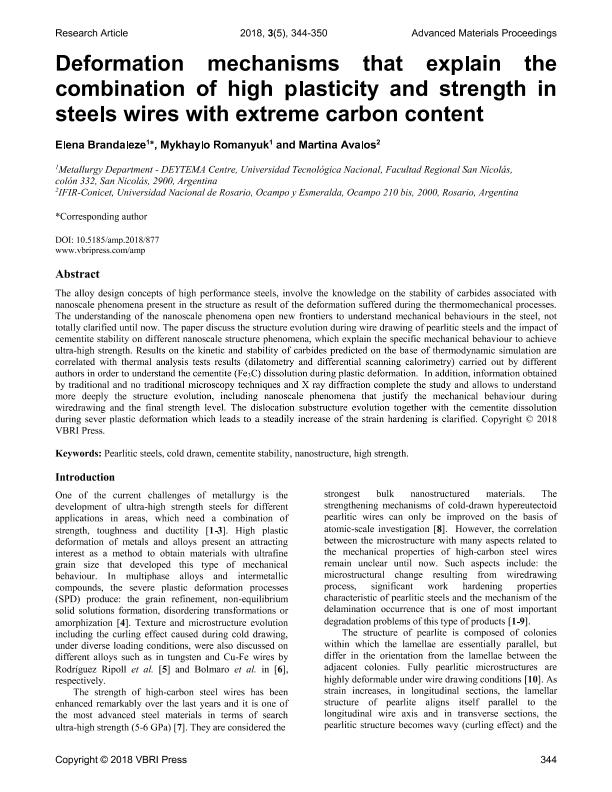Mostrar el registro sencillo del ítem
dc.contributor.author
Brandaleze, Elena

dc.contributor.author
Romanyuk, Mykhaylo
dc.contributor.author
Avalos, Martina Cecilia

dc.date.available
2019-11-25T18:45:25Z
dc.date.issued
2018-05
dc.identifier.citation
Brandaleze, Elena; Romanyuk, Mykhaylo; Avalos, Martina Cecilia; Deformation mechanisms that explain the combination of high plasticity and strength in steels wires with extreme carbon content; VBRI Press; Advanced Materials Proceedings; 3; 5; 5-2018; 344-350
dc.identifier.issn
2002-4428
dc.identifier.uri
http://hdl.handle.net/11336/89697
dc.description.abstract
The alloy design concepts of high performance steels, involve the knowledge on the stability of carbides associated with nanoscale phenomena present in the structure as result of the deformation suffered during the thermomechanical processes. The understanding of the nanoscale phenomena open new frontiers to understand mechanical behaviours in the steel, not totally clarified until now. The paper discuss the structure evolution during wire drawing of pearlitic steels and the impact of cementite stability on different nanoscale structure phenomena, which explain the specific mechanical behaviour to achieve ultra-high strength. Results on the kinetic and stability of carbides predicted on the base of thermodynamic simulation are correlated with thermal analysis tests results (dilatometry and differential scanning calorimetry) carried out by different authors in order to understand the cementite (Fe3C) dissolution during plastic deformation. In addition, information obtained by traditional and no traditional microscopy techniques and X ray diffraction complete the study and allows to understand more deeply the structure evolution, including nanoscale phenomena that justify the mechanical behaviour during wiredrawing and the final strength level. The dislocation substructure evolution together with the cementite dissolution during sever plastic deformation which leads to a steadily increase of the strain hardening is clarified.
dc.format
application/pdf
dc.language.iso
eng
dc.publisher
VBRI Press
dc.rights
info:eu-repo/semantics/openAccess
dc.rights.uri
https://creativecommons.org/licenses/by-nc-sa/2.5/ar/
dc.subject
PEARLITIC STEELS
dc.subject
COLD DRAWN
dc.subject
CEMENTITE STABILITY
dc.subject
NANOSTRUCTURE
dc.subject.classification
Ingeniería de los Materiales

dc.subject.classification
Ingeniería de los Materiales

dc.subject.classification
INGENIERÍAS Y TECNOLOGÍAS

dc.subject.classification
Ingeniería Mecánica

dc.subject.classification
Ingeniería Mecánica

dc.subject.classification
INGENIERÍAS Y TECNOLOGÍAS

dc.subject.classification
Física Atómica, Molecular y Química

dc.subject.classification
Ciencias Físicas

dc.subject.classification
CIENCIAS NATURALES Y EXACTAS

dc.title
Deformation mechanisms that explain the combination of high plasticity and strength in steels wires with extreme carbon content
dc.type
info:eu-repo/semantics/article
dc.type
info:ar-repo/semantics/artículo
dc.type
info:eu-repo/semantics/publishedVersion
dc.date.updated
2019-10-21T19:59:42Z
dc.journal.volume
3
dc.journal.number
5
dc.journal.pagination
344-350
dc.journal.pais
Suecia

dc.description.fil
Fil: Brandaleze, Elena. Deytema; Argentina
dc.description.fil
Fil: Romanyuk, Mykhaylo. Deytema; Argentina
dc.description.fil
Fil: Avalos, Martina Cecilia. Consejo Nacional de Investigaciones Científicas y Técnicas. Centro Científico Tecnológico Conicet - Rosario. Instituto de Física de Rosario. Universidad Nacional de Rosario. Instituto de Física de Rosario; Argentina
dc.journal.title
Advanced Materials Proceedings
dc.relation.alternativeid
info:eu-repo/semantics/altIdentifier/doi/http://dx.doi.org/10.5185/amp.2018/877
dc.relation.alternativeid
info:eu-repo/semantics/altIdentifier/url/https://www.vbripress.com/amp/articles/details/286/
Archivos asociados
